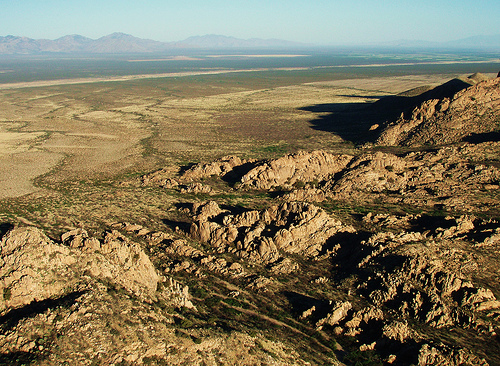Malpai Borderlands Group, Ranches of SE Arizona Face a New Threat
By: Amos S. Eno
Posted on:06/28/2010 Updated:07/14/2010This post is a continuation from last week’s, about the Malpai Borderlands Group, or MBG, a group of ranchers working to protect their land and ranching heritage.
This post is a continuation from last week’s, about the Malpai Borderlands Group, or MBG, a group of ranchers working to protect their land and ranching heritage. The Malpai’s territory straddles the Peloncillo Mountain and Animas Mountain ranges of southeast Arizona and the “bootheel” of New Mexico, nearly a million acres of unfragmented grasslands, valley vistas, and jagged peaks up to 8,500 feet.
For several years, the Malpai Borderlands Group tried to look the other way. They’d find trash, and occasionally illegal immigrants so exhausted and confused they were ready to call the Border Patrol themselves. “But it was like the elephant in the room,” during Malpai Board meetings, says Bill McDonald, MBG Executive Director.
After years of incidents - including broken fences, punctured pipelines that stole drinking water from cattle, lost people, and even misplaced bales of marijuana - the worst happened. On March 27, 2010, rancher Rob Krentz was checking his fences, riding his ATV and accompanied by his family dog. He was killed in a pasture not far from Bill’s property. Shot multiple times, his dog mortally wounded.
The last communication from Rob had been a radio call to his brother indicating that he’d found an illegal immigrant. When he did not meet his brother as planned, a day-long search ensued until Krentz was found. The speculation is that Krentz was murdered by a drug smuggler, possibly a scout, since people rarely cross the border alone.
A New Enemy to a Traditional Lifestyle
Once again, the Malpai ranchers find themselves at the mercy of a federal policy, this time one which has effectively driven the cross-border traffic in drugs and illegal immigrants away from the urban centers of southern California, Tucson and Phoenix toward their land. The agencies did not seem to believe that drug smugglers would try to cross the border in the forbidding Malpai country, but they have, with a vengeance.
California, Tucson and Phoenix toward their land. The agencies did not seem to believe that drug smugglers would try to cross the border in the forbidding Malpai country, but they have, with a vengeance.
Now the area is overrun with illegal immigrants of all kinds, because the drug trade controls the smuggling of both people and marijuana. Some kind of incident occurs at least 5 to 6 times per week, according to Bill, and now ironically, fires are becoming too common, set at the wrong time of year, purposely or accidentally, by immigrants.
Bill has sympathy for some of the people crossing, the ones who are just trying to find work, but he always calls the Border Patrol. He’s learned which ones to avoid, the “rough customers, with water jugs painted black and wearing dark clothes.”
There are no easy answers. The ranchers do not generally believe a higher fence is the solution, but rather a concerted effort to apprehend the smugglers. “It would make it easier for law enforcement if they were just going after the bad guys,” Bill says. However, the fierce topography makes communication by cell phone and radio dicey. As with so many problems, it boils down to a question of budgets and priorities.
Keeping the Pressure On, Not Giving Up
“The situation here has been made dangerous,” Bill says, “and we want to keep that in front of people so they don’t forget. In the long run, I’m optimistic. We’re going to continue to do the things we do, as best we can given our financial situation. We’re not going away, but the situation has changed because of this new element.”
One of the MBG’s most recent projects is a cooperative effort with both the BLM and the US Fish and Wildlife Service to protect endangered species of the Rio Yaqui by improving rangeland and riparian habitat. The San Bernardino National Wildlife Refuge, on the west side of the Malpai region, was established specifically to protect endangered fish in the American section of this river, which harbors species unique in the United States.
Fire planning with the federal agencies will improve perennial grass cover, in turn reducing erosion and boosting water filtration in the region. Restoration of the smaller draws that lead into the Rio Yaqui is the best opportunity to protect the Yaqui chub, Yaqui catfish, Yaqui topminnow, Mexican stoneroller, Yaqui sucker, and beautiful shiner from the rapacious exotic fish that threaten them elsewhere in the river’s main stem.
Malpai ranchers are restoring riparian stretches on the gully tributaries to the larger arroyos, using a “WHIP” grant from the Natural Resources Conservation Service (NRCS). They use rocks and branches to slow the water down, creating meanders that allow recharge and silt deposition so the habitat heals itself. In the past three years, they’ve installed more than 3,000 of the hand-built erosion control structures.
But as for the murderer of Rob Krentz, Bill says, “They haven’t caught the guy.”
Feedback
re: Malpai Borderlands Group, Ranches of SE Arizona Face a New ThreatBy: Kris Randall on: 07/15/2010Please note that in 2003, the US Fish and Wildlife Service provided funding to the Malpai Borderland Group to do similar erosion control work. Slowing the flow of water has encouraged sediment deposition and the development of grasses which improves watershed conditions.
 Sign In
Sign In
 Sign In
Sign In
